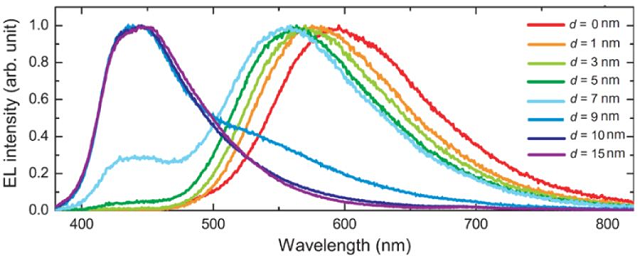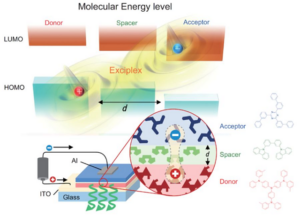A research group at the Centre for Organic Photonics and Electronics Research (OPERA) (Kyushu University, Japan) has developed an OLED technology that can emit red, green and blue light using the same organic material. Today’s OLEDs require three different kinds of organic molecules to achieve the same effect.
The energy emitted by OLED molecules shifting from an exciton (combined electron and hole) to a ground state is emitted as light in the form of photons. The energy of the excitor is as much as 0.5eV, making it difficult to freely control the exciton energy of the same molecule. This makes it necessary to use different molecules for the RGB colours.
An organic thin film consisting of three layers was developed by the research group. It is based on the same molecular system as OLED molecules. By changing the thickness of the middle layer, the group found that it was possible to control the exciton energy, and lifespan of the excitor.
The layers are the ‘donor’, ‘acceptor’ and ‘spacer’ layers. The first consists of electron-donating molecules (m-MTDATA). The second is made of electron-accepting molecules (T2T). The third consists of a middle layer whose excitation energy is higher than those of the donor and acceptor molecules (mCBP). These were formed into films with a thickness of several tens of nanometres, using a vacuum evaporation method, and the group analysed the process of excitor dissipation.
The figure below shows the emission spectrum of an OLED device using the three-layered organic thin film as a light-emitting layer. As the thickness of the spacer increases, the spectrum peak moves to the shorter wavelength side (an increase in exciton energy).
 Electroluminescent emission efficiency was found to improve as the thickness of the middle layer increases. When a three-layered film with a 5nm spacer layer was used as a light-emitting layer, the EL emission efficiency rose by more than 700% compared to a film with no spacer layer.
Electroluminescent emission efficiency was found to improve as the thickness of the middle layer increases. When a three-layered film with a 5nm spacer layer was used as a light-emitting layer, the EL emission efficiency rose by more than 700% compared to a film with no spacer layer.
The thermally activated delayed fluorescene (TADF) of the excitor was improved by controlling the distance between donor and acceptor layers.
The group said that its results show that the excitation state of organic semiconductor molecules can be freely controlled; not only by internal factors based on the molecular framework, but also by external factors.
The research was published Science Advances (http://tinyurl.com/hx4hm5c).

